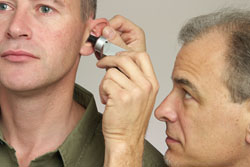According to musicians' audiologist Michael Santucci (right) of Sensaphonics, an ear exam is an important first step in preventing hearing loss. NILES, IL--Shure Incorporated has revealed the results of a study recently presented at the American Academy of Audiology annual meeting confirming that musicians suffer a higher incidence of hearing loss than the non-noise exposed population at large. Based upon the joint research of Shanda Brashears-Morlet of the Louisiana State University Health Sciences Center in New Orleans, Michael Santucci of Chicago-based Sensaphonics Hearing Conservation, and Thierry G. Morlet from the Auditory Physiology and Psychoacoustics Laboratory at the Alfred I. duPont Hospital for Children in Wilmington, DE, the inquiry's results confirmed that musicians' hearing thresholds were worse across almost the entire range of human hearing, and that the use of hearing protection devices is effective in reducing the risks to hearing health.
"We set out to examine the hearing of a large group of musicians, more than a thousand, and then compare the data collected to ISO 7029:2000 hearing standards for 250 Hz to 8 kHz," said Santucci. "The study sought to determine the incidence of hearing loss in the former group and give analysis to the associated risk factors involved."
In total, 1,018 musicians were initially included within the test group. After receiving an ear exam, hearing test, and answering a lifestyle/case history survey, members of this group with conductive hearing loss, a history of the use of certain medications known to be harmful to the ear, acoustic neuroma, or significant exposure to noise other than music were eliminated, leaving 887 subjects.
When compared to the ISO hearing standards, the musicians' thresholds were consistently worse for all frequencies except 8,000 Hz. The largest difference between musicians' hearing thresholds and norms were at 2,000, 3,000, 4,000, and 6,000 Hz. 39.0 percent of musicians had at least one frequency over 1,500 Hz with hearing thresholds 15 dB apart or more. 60 percent reported occasional tinnitus. 77.1 percent had at least one sign of hearing damage and either minimal hearing loss, a noise notch, asymmetry in hearing thresholds between ears, and/or tinnitus. Interestingly, those who reported tinnitus were not any more likely to have hearing loss. Noise notches-hearing loss at one octave above and below any frequency above 1,500 Hz-were found in all age groups but became more pronounced with age.
Some of the factors having the most profound impact on hearing were age, years of experience, hours of exposure, and the use of some type of hearing protection. Factors appearing not to have as much influence on hearing included the type of music exposed to (i.e., rock, jazz, or classical), hours since exposure, family history, diabetes, and the use of tobacco, alcohol, caffeine, or aspirin.
This study was funded as part of the Shure Listen Safe program, the company's corporate cause that supports hearing conservation. In addition to this study, Shure Listen Safe promotes hearing conservation by providing free hearing screenings and distributing hearing protection devices at professional audio industry trade shows, music conferences and festivals, and to Shure's employees. For more information visit www.sensphonics.com.










